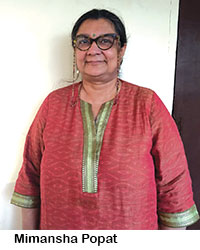Spatial intelligence is capability to visualise three-dimensional images, shapes and positions of an object in relation to another object and is vital for developing mathematical thinking and conceptual understanding – Dipta Joshi
 Spatial intelligence or visual-spatial processing may sound unfamiliar and highfalutin. But the truth is that you are using this intelligence in everyday activities.
Spatial intelligence or visual-spatial processing may sound unfamiliar and highfalutin. But the truth is that you are using this intelligence in everyday activities.
Think of the times you visualised how to pack differing items into a suitcase. Or how you know which Russian Matryoshka wooden doll fits into another. Spatial intelligence is capability to visualise three-dimensional images, shapes and positions of an object in relation to another object.
The development of children’s visual-spatial intelligence gained traction in the 1980s after Dr. Howard Gardner, celebrated professor of education at Harvard University, in his book Frames of Mind — The Theory of Multiple Intelligences (1983), propounded that all humans have one or more of eight different intelligences — visual-spatial, logical-mathematical, linguistic-verbal, bodily-kinaesthetic, interpersonal, intrapersonal and naturalistic. According to Gardner, individuals with high visual-spatial intelligence are adept at solving puzzles, reading, drawing, painting, reading maps and are better at science and maths as they have the capability to generate sharp mental images. This facilitates calculation, measurement and pattern recognition which is important for excellence in geometry, chemistry and physics.
“The right side of the brain controls spatial tasks and ability to comprehend three-dimensional shapes and images. Research has shown that spatial intelligence is critical to the development of mathematical thinking, conceptual understanding, and enables success in careers such as medical surgery, architecture, engineering, professional sports and art. Educators are becoming increasingly aware of the vital connection between spatial intelligence and high academic performance,” says Suzanne Perkowsky, co-founder and head of education, New Nordic School, a Finland-based education solutions company.
Though children with higher visual-spatial intelligence are likely to excel in architecture, art or engineering, it’s pertinent to note this intelligence is required even if to a lesser degree, in all careers and to perform everyday tasks. Therefore, it’s important to encourage children to develop this intelligence from young age. A University of Chicago research study titled ‘Relation Between Spatial Skill and Early Numbers Knowledge’, published in Development Psychology (2012) found that exposing children between the ages of five and six to spatial learning activities accelerated their understanding of maths concepts and abstract reasoning.
 “Spatial reasoning skills can be developed in several ways and are especially important for success and innovation in STEM (science, technology, engineering, and maths) careers. Teachers and parents should introduce children to activities such as solving puzzles, using maps, visual aids, and drawing from early age to improve their spatial intelligence. Simple tasks such as asking three-five-year-old preschoolers to copy shapes from a blackboard on paper, helps them develop their spatial and fine motor skills. The development of this intelligence will help them in any career they choose,” says Dr. Akhil Shahani, the Mumbai-based chairman of Global Discovery Schools, a chain of 14 institutions across India.
“Spatial reasoning skills can be developed in several ways and are especially important for success and innovation in STEM (science, technology, engineering, and maths) careers. Teachers and parents should introduce children to activities such as solving puzzles, using maps, visual aids, and drawing from early age to improve their spatial intelligence. Simple tasks such as asking three-five-year-old preschoolers to copy shapes from a blackboard on paper, helps them develop their spatial and fine motor skills. The development of this intelligence will help them in any career they choose,” says Dr. Akhil Shahani, the Mumbai-based chairman of Global Discovery Schools, a chain of 14 institutions across India.
 While introducing spatial tasks in early childhood education is important, child development experts believe that stimulating spatial intelligence in the middle years between ages 8-12 is more crucial. “Children in primary school should be exposed and encouraged to learn experientially and given the freedom to explore through play activities. Although this is one of the most important of the eight intelligences it is often neglected. Educators and parents need to do more to develop the capability of students to visualise three-dimensional shapes and process information,” says Mimansha Popat, psychotherapist at Prafulta Psychological Services, Mumbai.
While introducing spatial tasks in early childhood education is important, child development experts believe that stimulating spatial intelligence in the middle years between ages 8-12 is more crucial. “Children in primary school should be exposed and encouraged to learn experientially and given the freedom to explore through play activities. Although this is one of the most important of the eight intelligences it is often neglected. Educators and parents need to do more to develop the capability of students to visualise three-dimensional shapes and process information,” says Mimansha Popat, psychotherapist at Prafulta Psychological Services, Mumbai.
Here are some activities recommended by child development experts to improve visual-spatial intelligence of children in the age group 8-12.
Free play (outdoor and indoors) exposes children to spatial experiences in their immediate environment. For instance, knowing if they can pass through a narrow corridor or fit under the living room sofa helps them develop spatial reasoning.
Playing informal games such as hopscotch, marbles and lagori (seven tiles) and formal rules-driven games such as badminton, promotes body control and balance and helps children understand the connotations of space and distance.
Drawing, especially landscapes and cityscapes, helps children become familiar with angles and perspective.
Amateur photography develops visual perspective.
Maps reading helps children grasp concepts of space and direction. Asking children to help with navigation using Google maps enables them to learn about multiple travel options in the real world.
Children’s sense of direction can be developed by asking them to gather specific objects from different locations in a house. Parents could also draw charts and ask their children to colour items either on the left, right, top or bottom of a page.
Several educational games and puzzles such as Tangram and Katimino enhance spatial reasoning capability.
Spatial celebrity profiles
Here’s a list of artists and explorers who used their spatial skills to pursue successful careers. Each of them also happened to live with a disability.
Leonardo da Vinci
Italian painter, sculptor, architect, musician, engineer, and scientist. Renaissance Man. He had a learning disability.
Admiral Peary
American arctic explorer and naval officer. He had a communicative disorder.
Vincent Van Gogh
Post-impressionist painter, Netherlands-born Van Gogh had epilepsy and struggled with mental illness, including depression and dementia.
Marc Chagall
Russian cubist and expressionist painter. He had a communicative disorder.
Henri de Toulouse-Lautrec
French painter and lithographer. Lautrec fell and broke both legs when he was a child and was permanently stunted.
Exercise
Ask your children if they can think of any famous people who have high spatial intelligence. Start them off with a few familiar names:
Frank Lloyd Wright
Andy Warhol
Georgia O’Keeffe
Martha Stewart
The Wright Brothers
Amelia Earhart
Source: Multiple Intelligences in the Classroom by Thomas Armstrong (ASCD 1994)
























